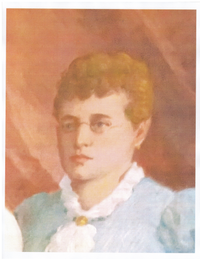Mercedes Arias
Mercedes Arias | |
|---|---|
 Mercedes Arias, c. 1880 | |
| Background information | |
| Birth name | Mercedes Arias Ventura |
| Born | ca. 1860 |
| Origin | Ponce, Puerto Rico |
| Died | 7 January 1954[citation needed] Ponce, Puerto Rico |
| Genres | Danza |
| Occupation(s) | Composer, musician, music teacher |
| Instruments | Piano |
| Years active | ca. 1880 – ca.1920 |
Mercedes Arias (ca. 1860 – 7 January 1954[citation needed]) was a Puerto Rican musician and composer from Ponce, Puerto Rico.[1] Among her compositions are "Renacimiento" (Renaissance), and "Flores y Perlas" (Flowers and Pearls).
Professional career[]
Arias was trained by Juan Morel Campos and Julio Arteaga. She was "one of the greatest pianists and composers Ponce had". Her compositors are "saturated with beauty." Among them are "Renacimiento" (Renaissance), and "Flores y Perlas" (Flowers and Pearls). She was one of the first musician contracted by Jaime Pericas Díaz in his concert hall orchestra in 1926. She was also highly applauded and regarded in her solo concerts. Under the leadership of Juan Morel Campos, Lizzie Graham and Arias, many representations, concerts, discussions and recitals occurred in Ponce. She also worked at Teatro Delicias interpreting the piano sound synchronization that accompanied the soundless films of the time.[2] During the 1880s, Julio Arteaga, Juan Ríos Ovalle and Mercedes Arias would often perform together at popular events.[3]
Personal life[]
Arias was a student of Juan Morel Campos.[4] Many people who know about Arias, get their knowledge through stories about Juan Morel Campos, as it is said that Mercedes Arias was Morel Campos's secret love. The story goes that the two saw each other romantically in the evenings in what is now Callejon Amor/Paseo Arias.[note 1] However, due to race issues, her family did not approve of the relationship and they were never married.[5] There was a lot of gossip in the streets of Ponce regarding the platonic love between Morel Campos and Arias.[6]
Music teacher[]
Among her disciples was the father of Hector Campos Parsi and who, together with his wife, were decisive in influencing the future musical career of little Hector.[7] Arias would also volunteer her time in local public school activities related to music classes. For example, in 1904 she funded herself to travel to New York City with a group of public school educators from Ponce in support of two music teachers in that group.[8] In 1892, Arias organized a concert to showcase the advancement her students had made. Among her disciples were Elisa Tavárez, Amelia Serra, Lila Salazar, Leonor Valdivieso, Celina Besosa, María Rodríguez, Panchita Colón, and María Laguna and Mercedes Laguna.[9]
Death[]
It has been said that in her deathbed, Arias asked to be buried with copies of the musical compositions that Morel Campos had dedicated to her. She was buried at the Cementerio Católico San Vicente de Paul cemetery.[10]
Legacy[]
- *Mercedes Arias is commemorated at the Ponce Park of the Illustrious Ponce Citizens.[11]
Notes[]
- ^ The Ponce Municipal Government named the street "Paseo Arias" after a different Arias, Antonio Arias Ventura, the long-time employee of the Banco Crédito y Ahorro Ponceño who started as a custodian and rose to become the bank's general manager.
References[]
- ^ Memorias de don Luis A. Ferré: A continuación un capítulo de la autobiografía de don Luis A. Ferré, narrada por su hija Rosario Ferré en el libro "Memorias de Ponce", libro publicado en 1992. El Nuevo Dia. Guaynabo, Puerto Rico. 22 October 2011. Retrieved 7 March 2018.
- ^ Mercedes Arias: entre las glorias de la historia musical de Ponce: En veladas y conciertos recibió constantes ovaciones, siendo muy aplaudida por la ejecución de su repertorio. Néstor Murray-Irizarry. La Perla del Sur. Ponce, Puerto Rico. Year 35. Issue 1788. Pages 8–9. 7 March 2018. Retrieved 7 March 2018.
- ^ Socorro Giron. Ponce, el teatro La Perla, y La Campana de la Almudaina. Ponce, Puerto Rico: Ponce Municipal Government. Third edition. 1992. page 273.
- ^ Mercedes Arias: entre las glorias de la historia musical de Ponce: En veladas y conciertos recibió constantes ovaciones, siendo muy aplaudida por la ejecución de su repertorio. Néstor Murray-Irizarry. La Perla del Sur. Ponce, Puerto Rico. Year 35. Issue 1788. Pages 8–9. 7 March 2018. Retrieved 7 March 2018.
- ^ Caminata Guiada Centro Historico de Ponce:: “Ponce es nuestro; Ponce es del que nos visita.” Archived 4 October 2013 at the Wayback Machine Ponce Municipal Government. n.d. Retrieved 8 May 2016.
- ^ Socorro Giron. Ponce, el teatro La Perla, y La Campana de la Almudaina. Ponce Municipal Government. 1992. p.285.
- ^ Hector Campos Parsi. Gustavo Batista. 2018. Retrieved 7 March 2018.
- ^ Noticias de Ponce. United States Library of Congress. Chronicling America. La Democracia. Ponce, Puerto Rico. 24 June 1904. Page 2. Retrieved 7 March 2018.
- ^ Mercedes Arias: entre las glorias de la historia musical de Ponce: En veladas y conciertos recibió constantes ovaciones, siendo muy aplaudida por la ejecución de su repertorio. Néstor Murray-Irizarry. La Perla del Sur. Ponce, Puerto Rico. Year 35. Issue 1788. Pages 8–9. 7 March 2018. Retrieved 7 March 2018.
- ^ Mercedes Arias: entre las glorias de la historia musical de Ponce: En veladas y conciertos recibió constantes ovaciones, siendo muy aplaudida por la ejecución de su repertorio. Néstor Murray-Irizarry. La Perla del Sur. Ponce, Puerto Rico. Year 35. Issue 1788. Pages 8–9. 7 March 2018. Retrieved 7 March 2018.
- ^ Music. Travel Ponce.com. Retrieved 7 March 2018.
See also[]
- Burials at Cementerio Católico San Vicente de Paul
- Puerto Rican composers
- Puerto Rican women composers
- Musicians from Ponce